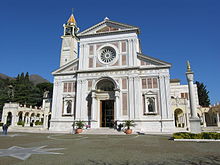art.wikisort.org - Sculpture
The Bambino Gesu of Arenzano locally known as Il Grande Piccinino (Lit: Child Jesus of Arenzano, the Great Little Child) is a Roman Catholic devotional image depicting the Child Jesus venerated by the Genoese faithful.[1]
This article needs additional citations for verification. (January 2016) |
| Bambino Gesu of Arenzano Child Jesus of Arenzano il Grande Piccinino | |
|---|---|
 The Santo Bambino Gesu of Arenzano "il Piccinino" enshrined within the titular Basilica | |
| Location | Arenzano, Genoa |
| Date | 1902 |
| Witness | Marquise Delphina Gavotti of Savona Prior John of the Cross |
| Type | Wooden image |
| Approval | Pope Pius XI |
| Shrine | Basilica of Bambino Gesu of Arenzano |
The image takes its iconography from a painting of Infant Jesus of Prague which was brought by the Carmelite Order who wanted to propagate its devotion in the area. Italian Marchioness Delphina Savona used her personal funds to build a statuary image in 1902, which merited a Pontifical decree of coronation in 1924, partly due to her pious fanaticism to Jesus Christ under this title.
Various miraculous claims are associated with the image by its pilgrims, now preserved within the basilica. The image is celebrated with an annual religious feast on 1 September.
History

The image was donated by the Marquise Delphina Gavotti of Savona and was presented to the built shrine on 2 June 1902. It replaced a picture image of the Infant Jesus of Prague brought by the Carmelite Order on 25 September 1900, which was located beneath the statue of Our Lady of Mount Carmel.
Pope Pius XI granted a Canonical coronation to the venerated image on 24 February 1924 via his Papal legate Cardinal Rafael Merry del Val. The solemn ceremony was executed on 6 September 1924 and was attended by many notable prelates, namely the young seminarian at the time, Cardinal Giuseppe Siri and Queen Margherita of Savoy.
The same Pontiff raised the sanctuary to the status of a Minor Basilica on 6 May 1928 through an Apostolic decree signed by the Vatican Secretary of State Cardinal Pietro Gasparri, where the image is permanently enshrined today.[2]
See also
- Infant Jesus of Mechelen
- Santo Nino de Cebu
- List of canonically crowned images
References
- "The Miraculous Bambino Gesu". Italian Slow Walks. 4 February 2011. Retrieved 22 November 2014.
- "Arcidiocesi di Genova - Santuario Bambino di Praga - Arenzano". Archived from the original on 2016-01-26. Retrieved 2016-01-09.
Другой контент может иметь иную лицензию. Перед использованием материалов сайта WikiSort.org внимательно изучите правила лицензирования конкретных элементов наполнения сайта.
WikiSort.org - проект по пересортировке и дополнению контента Википедии